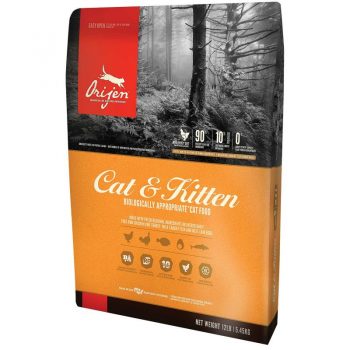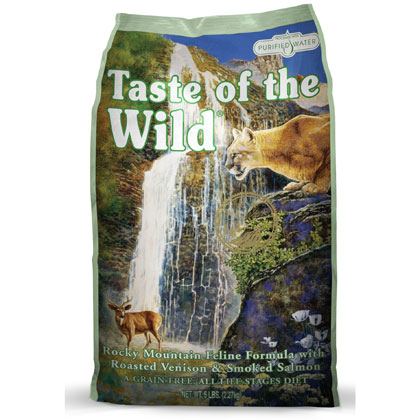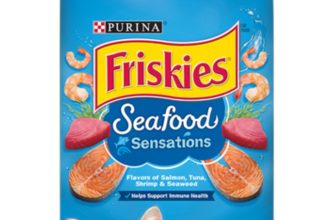Orijen Cat Food Review

With years of experience in the pet food industry and feline nutrition I can honestly say Orijen has proven to be one of the best dry cat foods money can buy.
Many find the brand expensive, but through the course of this Orijen cat food review you’ll learn the real truth about why this is worth feeding your cat, and also the real cost of feeding one of the many “cheap” cat foods made of grain for carnivores.
Orijen cat food review – Cat & Kitten
What the marketing says
I’ll skirt over the marketing for Orijen cat foods as the ingredients really speak for themselves with this food.
For Orijen Cat & Kitten the Orijen website states 90% poultry/fish/egg ingredients, 10% vegetables/fruit/botanicals, and 0% grain/potato/tapioca/plant protein concentrates.
That’s incredible for a cat food! And that’s just the start of it.
I’ll clarify a little here (seeing as the purpose of these reviews are to tell you the real truth). The 90%/10%/0% claim is based on wet-weight, meaning these are the ratios of the ingredients prior to being cooked into a kibble. These percentages differ with the final product, but it’s only a small point.
Orijen cat foods don’t use rendered meats. Trust me when I say that’s a very good thing. Meat rendering is a gruesome industry, and rendered meats are often more rendered carcass than anything overly beneficial. When you see something like “chicken meal” on the ingredients then that’s what we’re talking about.
Orijen also include whole-prey ingredients including organs, cartilage, bone, as well as whole fish and eggs. These are the inclusions which matter as they contain the richest sources of nutrients.
I’ll raise one last quality point which shows how good this product is – liver is included as a freeze-dried ingredient. So why is that good?
Freeze drying is the best method of reducing moisture from a food to leave nutrition intact (and extend shelf life). This means the liver (a very nutritious inclusion) will retain as much nutrition as possible, far more than if it were cooked into a kibble.
What the ingredients really say
The ingredients in Orijen cat foods are astounding. I’ve been a pet nutritionist for some time, and it still makes my jaw drop seeing how good the ingredients are in these cat foods.
I don’t even need to explain how good they are. These are the main ingredients in Orijen Cat & Kitten:
Deboned chicken, deboned turkey, cage-free eggs, Atlantic flounder, whole Atlantic mackerel, chicken liver, turkey liver, whole Atlantic herring, chicken heart, turkey heart, dehydrated chicken, dehydrated turkey, dehydrated mackerel, dehydrated chicken liver, dehydrated egg.
That’s not the last of the “whole-prey” ingredients either, as we also find chicken necks, chicken kidney, pollock oil, ground chicken bone, chicken cartilage, and the freeze-dried chicken liver we mentioned earlier.
Incredible!
Alongside the meat we find a range of legumes, including various lentils, beans, and peas. I estimate the carbohydrates to be as little as 21% which means these ingredients are in a decent moderation, and as far as non-meat ingredients go in a cat food these are respectable inclusions. These should serve to round off nutrition.
If you’re really switched on you’ll realise 21% carbohydrates is strange given the Orijen claim of 90% meat/fish/eggs. The reason for this is the 21% is based on dry matter, so once cooked into a kibble with moisture cooked off. Don’t worry though, this is still very good.
The 40% protein (mostly from whole prey ingredients) and 20% fat (from animal fats) is very very good for a dry cat food.
I’m conscious of how verbose this Orijen cat food review is getting, and I don’t want to bore you, so I’ll skirt over the remainder of the ingredients.
You’ll be pleased to know there’s no nasties whatsoever.
The weirdly named ingredients with crazy names like lactobacillus and fermentation products are pre and probiotics for gut health. These help your cat digest their food and maintain an efficient digestive systems.
We also find a range of fruits and vegetables. You may hear things like “fruits and veggies are not a carnivore diet”, but that’s not true. These ingredients cats in the wild get from the gut content of prey, and Orijen has included these ingredients to mimic that.
I’ll end on turmeric as an excellent spice. It’s anti-carcinogenic, anti-viral, anti-inflammatory, anti-bacterial, and anti-fungal. In my opinion turmeric should be in every cat food.
Should I feed my cat Orijen?
Whether you have a kitten, adult cat, or senior cat, Orijen is a very good choice if you can afford it. If you can’t afford it, then even if it’s part of the diet then this would offer excellent nutrition as well as variety.
I’ll conclude the Orijen cat food review by saying this is by far one of the best dry cat foods available worldwide.
When you consider most cat foods are made mostly of grains which are likely the cause so many cats end up with urinary health problems, kidney failure, and premature death after $$$$s in vets bills, Orijen probably doesn’t seem as costly.
Give it a go!
Where to buy Orijen cat food

For the best prices why not order on Amazon.com?
Orijen FAQ
I’ve found a number of common questions arise with Orijen cat and dog foods over the years, and will endeavour to answer these questions in this FAQ.
Is Orijen cat food suitable for urinary problems?
Orijen claim on their website their cat foods promote urinary health due to a high meat content and low magnesium.
Urinary problems are common in cats, and FLUTD is one of the most common diseases affecting cats worldwide.
This is not surprising given most cat foods are poor quality, made sufficiently of grains and other ingredients which are hard for a carnivore to digest. It must also be considered cats are not proactive drinkers and kibble does not contain much moisture.
In the case of a kibble like Orijen cat & kitten you are feeding ingredients inline with the digestive system of a cat, and this will go a long way to maintaining urinary health. As with any kibble diet it is also essential to ensure your cat has a sufficient clean water intake.
Read more on the Orijen FAQ.
Should I be worried about the 2018 class-action lawsuit?
It is important to note most American and Canadian brands of pet food are tarnished with one or more class-action lawsuits. In fact Mars and Nestle who make most pet food brands are inundated with class-action lawsuits which have continued for many years. It can be assumed corporate pet food manufacturers are often instigators of class-action lawsuits against competitor brands.
The lawsuit against Champion Petfoods, makers of Orijen and Acana, was filed on March 1, 2018, remains an unsubstantiated accusation of negligence and a failure to disclose the presence of heavy metals and toxins in it’s pet foods. The root information came from ratings from the Clean Label Project.
What many fail to realise is heavy metals and toxins are found in most pet food products (and human food products), and are often in safe and sometimes beneficial moderations. The FDA even has a set of standards which state safe levels.
In the case of Champion Petfoods, an average of 0.89 mg/arsenic was found in Orijen and Acana, which is much lower than the allowable maximum limit of 12.50 mg/kg.
This suggests an accusation that Champion Petfoods is negligent for products containing arsenic is a result of bad science.
Who owns Orijen?
Orijen is owned by Champion Petfoods, with manufacturing facilities in Alberta, Canada, and Kentucky, U.S.A. Champion Petfoods also manufacturer the ACANA brand.
Why would Orijen cause my cat to vomit?
It is common for a cat to vomit or refuse to eat a newly introduced food, and this is occasionally the case with Orijen. It is important to consider why, and there may be a simple reason for this.
If your cat has been fed an unvaried diet prior to the change, particularly with a carbohydrate-based kibble, then this may have led to intolerance build-up. Humans build up intolerances when a food is either excluded from a diet or our diet has been unvaried, and the same applies to our cats. Cats can be confused by a new food which should be introduced gradually, and in some cases additives in the prior food have caused an addiction.
Ingredients
Ingredients of Orijen cat food (Cat & Kitten)
Deboned chicken, deboned turkey, cage-free eggs, Atlantic flounder, whole Atlantic mackerel, chicken liver, turkey liver, whole Atlantic herring, chicken heart, turkey heart, dehydrated chicken, dehydrated turkey, dehydrated mackerel, dehydrated chicken liver, dehydrated egg, whole red lentils, whole pinto beans, chicken fat, chicken necks, chicken kidney, whole green peas, whole green lentils, whole navy beans, whole chickpeas, natural chicken flavor, pollock oil, ground chicken bone, chicken cartilage, lentil fiber, turkey cartilage, choline chloride, whole pumpkin, whole butternut squash, mixed tocopherols (preservative), dried kelp, zinc proteinate, freeze-dried chicken liver, kale, spinach, mustard greens, collard greens, turnip greens, whole carrots, apples, pears, pumpkin seeds, sunflower seeds, thiamine mononitrate, copper proteinate, chicory root, turmeric, sarsaparilla root, althea root, rosehips, juniper berries, dried lactobacillus acidophilus fermentation product, dried bifidobacterium animalis fermentation product, dried lactobacillus casei fermentation product.
Guaranteed analysis
Guaranteed analysis of Orijen cat food (Cat & Kitten):
| Protein | (min) 40% |
| Fat | (min) 20% |
| Crude Fibre | (max) 3% |
| Carbohydrates * | Estimated 21%. |
If our Orijen cat food review has been enlightening, or if you feed Orijen and can vouch for it (or against it) then make sure you say so in the comments! Oh, and share this review with others in your cat communities! Thanks!







